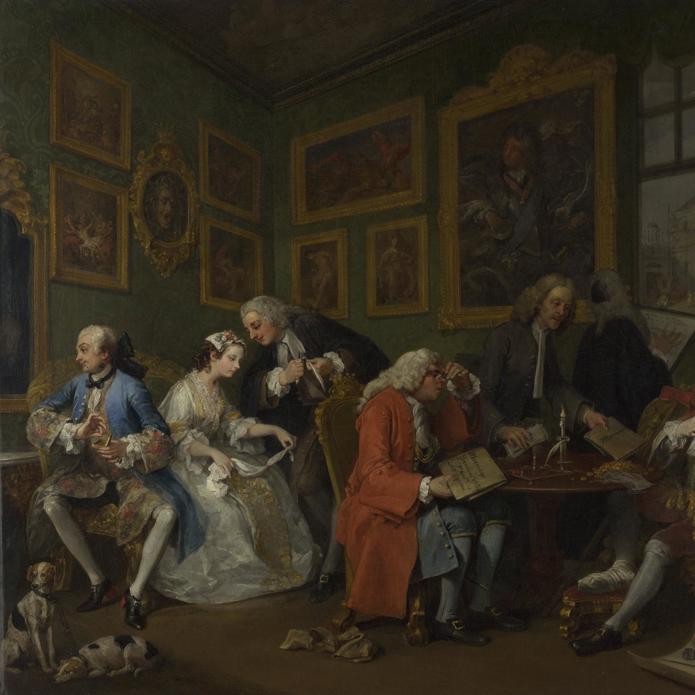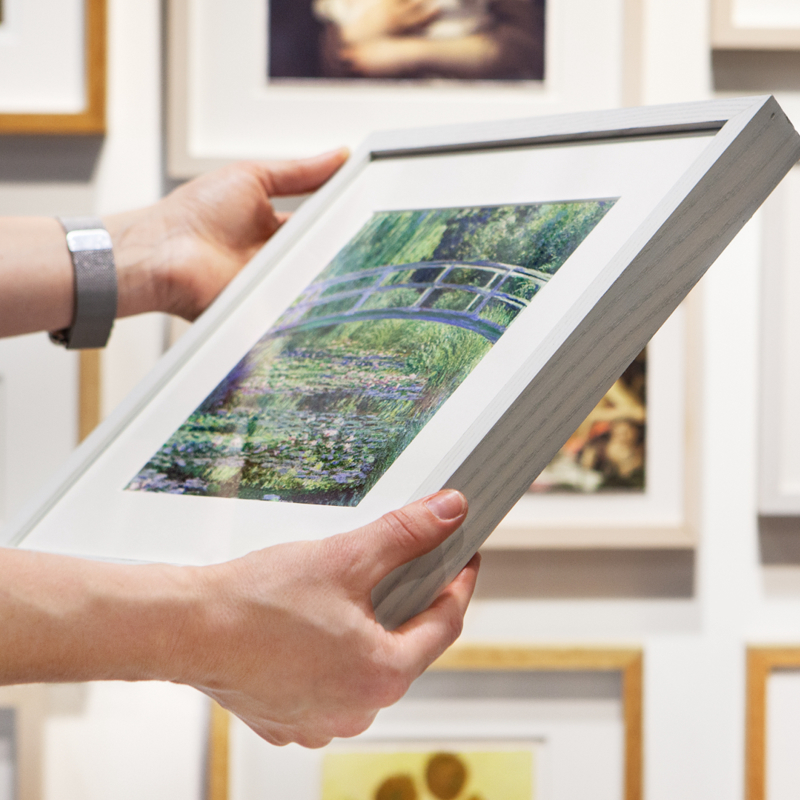William Hogarth, 'Marriage A-la-Mode: 2, The Tête à Tête', about 1743
About the work
Overview
This is the second in Hogarth’s series of six paintings titled Marriage A-la-Mode. It is a few months after the wedding of the Earl of Squander’s son to the Alderman’s daughter. The bride stretches sleepily, apparently after spending the whole night playing cards. The groom sprawls in his chair, exhausted from a night of debauchery on the town – the small dog tugs a girl’s muslin cap out of his pocket, and a second muslin cap is wound round the hilt of his broken sword. The large black spot on his neck denotes syphilis.
Two fiddle cases lie on top of one another on an overturned chair, suggesting that the Viscountess has been spending the evening in activities more intimate than simply playing whist. The drawing room is a battleground for the silent dislike between the couple and the disharmony of their possessions. The steward of the household rolls his eyes up to heaven as he exits with a wad of unpaid bills.
Key facts
Details
- Full title
- Marriage A-la-Mode: 2, The Tête à Tête
- Artist
- William Hogarth
- Artist dates
- 1697 - 1764
- Part of the series
- Marriage A-la-Mode
- Date made
- About 1743
- Medium and support
- Oil on canvas
- Dimensions
- 69.9 × 90.8 cm
- Inscription summary
- Inscribed
- Acquisition credit
- Bought, 1824
- Inventory number
- NG114
- Location
- Room 34
- Collection
- Main Collection
- Previous owners
- Frame
- 18th-century English Frame
Provenance
Additional information
Text extracted from the ‘Provenance’ section of the catalogue entry in Judy Egerton, ‘National Gallery Catalogues: The British Paintings’, London 2000; for further information, see the full catalogue entry.
Exhibition history
-
2019Hogarth: Place and ProgressSir John Soane's Museum9 October 2019 - 5 January 2020
-
2020SinThe National Gallery (London)7 October 2020 - 3 January 2021
-
2021Hogarth and EuropeTate Britain1 November 2021 - 20 March 2022
-
2023Hogarth’s Britons: Succession, Patriotism, and the 1745 Jacobite RebellionDerby Museums10 March 2023 - 4 June 2023
Bibliography
-
1814British Institution, Catalogue of Pictures by the Late William Hogarth, Richard Wilson, Thomas Gainsborough, and J. Zoffani, London 1814
-
1959Davies, Martin, National Gallery Catalogues: British School, 2nd edn (revised), London 1959
-
2000Egerton, Judy, National Gallery Catalogues: The British Paintings, revised edn, London 2000
-
2001
C. Baker and T. Henry, The National Gallery: Complete Illustrated Catalogue, London 2001
Frame
This carved and oil-gilt frame was made in England in the eighteenth century. Known as a ‘Carlo Maratta’ frame, it is named after the Italian artist Carlo Maratta. The back edge is decorated with a leaf-and-tongue design and the elegant outward-curving top is adorned with a pearl motif. The deep central hollow is embellished with acanthus leaves and shields, as well as a ribbon-and-stick motif near the sight edge.
The first owner of the painting, John Lane, recorded that William Hogarth’s Marriage A-la-Mode series was originally framed in Carlo Maratta frames that cost Hogarth four guineas each. The paintings have remained in their original frames, although these were altered in the nineteenth century to allow the fitting of glazing doors and were restored and regilded in the twentieth century.
Engravings of the Hogarth series were published in 1745. These were probably framed in what became known as ‘Hogarth frames’, used for his works on paper. They were typically made from pearwood, which takes stain well to create an ebonised finish. The finely grouped mouldings of these frames often include a gilt slip and leaf motif at the sight edge.
About this record
If you know more about this work or have spotted an error, please contact us. Please note that exhibition histories are listed from 2009 onwards. Bibliographies may not be complete; more comprehensive information is available in the National Gallery Library.
Images
About the series: Marriage A-la-Mode

Overview
For centuries, the English have been fascinated by the sexual exploits and squalid greed of the aristocracy, and these are the subjects of the six-part series Marriage A-la-Mode, which illustrates the disastrous consequences of marrying for money rather than love. The basic story is of a marriage arranged by two self-seeking fathers – a spendthrift nobleman who needs cash and a wealthy City of London merchant who wants to buy into the aristocracy. It was Hogarth’s first moralising series satirising the upper classes.
The six pictures were painted in about 1743 to be engraved and then offered for sale after the engravings were finished. The engravings are uncoloured, reversed versions of the paintings. Published in 1745, the engravings were offered to subscribers at a guinea a set. They proved instantly popular and gave Hogarth’s work a wide audience. The paintings were offered for sale by twelve noon on 6 June 1751, but only attracted two bidders, one of whom bought them all for £126.










